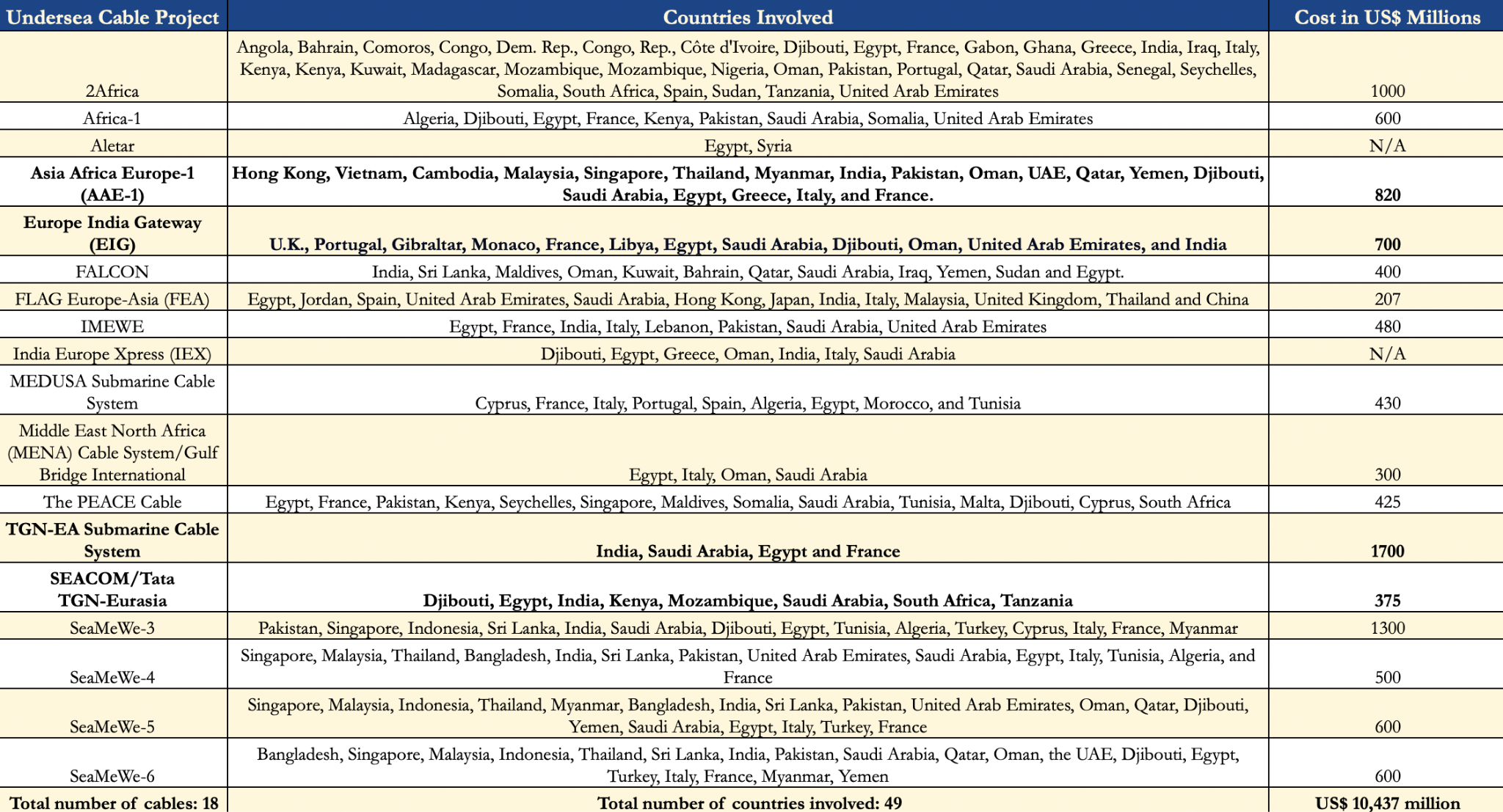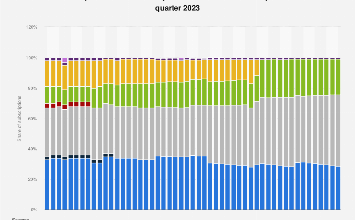The Red Sea cable disruptions

Months after the Houthi assaults on commercial sea-faring vessels traversing the Red Sea, the rebels exacerbated pressures on the Western governments by damaging critical sub-sea optic fibre cables near the Yemeni coast. Sub-sea cables are essential global telecommunications infrastructure and carry 99 percent of global internet traffic. The Red Sea hosts more than 15 such sub-sea cables responsible for connecting Europe and Asia, carrying 80 percent of Asia’s westward traffic. Globally, that is equivalent to 17 percent of data traffic.
Image 1: Subsea cables traversing the Red Sea seabed

Source: Middle East Eye
The persisting damage to four cables—SEACOM, TGN, AAE-1 and EIG—has disrupted 25 percent of telecommunications traffic in West Asia and North Africa (WANA) and had ripple effects as far as South Africa, where even basic software/cloud-based services such as Office 365, a Microsoft-owned cloud-powered productivity platform, were impacted. With geopolitical contestation and conflicts shifting beneath the waves, the criticality of sub-sea telecommunications assets has acquired renewed significance. This article assesses the geopolitical and geoeconomic implications of the sub-sea disruption in the Red Sea in the aftermath of the attack.
Criticality of the Red Sea cables
On 22 February 2024, Houthi missiles sank a British bulk carrier, the Rubymar, that was carrying 41,000 tons of inflammable fertiliser. Its sinking caused a 38 km wide oil spill but more interestingly, the Houthis (and several media reports) noted the ship’s anchor dragging across the seabed damaging four undersea cables. Of the 28 participant countries in the four damaged subsea cables, 17 are African, which faced problems in digital connectivity. Approximately 100 million people in over a dozen West and North African countries were negatively impacted, with Ghana, Liberia and Côte d’Ivoire experiencing internet outrages between seven to ten days.
A Telegram channel affiliated with the Houthi rebels shared a map of networks of submarine cables in the Mediterranean Sea, the Red Sea, the Arabian Sea, and the Persian Gulf.
The United Nations-recognised Yemenese government indicated in February 2024, that the Houthi rebels lack equipment to target deep-sea digital infrastructure assets, nonetheless, they have demonstrated their intentions of causing damage to the cables. In December 2023, a Telegram channel affiliated with the Houthi rebels shared a map of networks of submarine cables in the Mediterranean Sea, the Red Sea, the Arabian Sea, and the Persian Gulf. Moreover, the relatively shallow waters in the Red Sea make the cables susceptible to acts of subversion and collateral damage.
Yet this susceptibility hasn’t stopped telecom companies’ interest in the region. Between 2000 and 2024, over 30 telecom companies including Huawei, SubCom, Orange, Jio Infocomm, Tata Technologies, Amazon, Google, NEC and Alcatel Lucent invested US$ 10.43 billion in laying 18 undersea cables in the Red Sea, which transmits data from Asia to Europe. NEC (Japan), SubCom (USA), HMN Tech (China) and Alcatel Lucent (France) collectively hold 82 percent of the market share in laying, maintaining and repairing undersea cables.
Table 1: Subsea Cables in the Red Sea

Source: SubTel Forum
The Houthi attacks disrupted data traffic by damaging the SEACOM, TGN, AAE-1 and EIG undersea cables, worth approximately US$ 3.5 billion. The damage impacted nearly a quarter of the total regional data traffic and exacerbated pressures on the telecommunications industry, whose private players are mostly responsible for maintaining data flows in the WANA region. Companies such as SubCom, Ogero, Orange, Bayobab, Google, Meta, and Vodafone mitigated the disruptive effects by rerouting data traffic over land-based routes and through other cables—PEACE, 2AFRICA, FALCON, IEX, Equiano, WACS, etc.—connecting Asia, Africa, and Europe.
Conflict in critical digital infrastructure chokepoints such as the Red Sea further exacerbates security concerns.
While the impact of the damage is more or less contained, it opens a new chapter in the geopolitical contestation, where such a subsea network can become a pawn in the larger conflict among the adversaries. It poses a real challenge to global telecom infrastructure and exposes the risks due to a lack of global security infrastructure and laws surrounding subsea cables. The sheer expanse of the web of subsea cables makes ensuring their protection difficult. Conflict in critical digital infrastructure chokepoints such as the Red Sea further exacerbates security concerns. Moreover, given the Red Sea’s strategic location, exploring alternative routes to it is difficult. Unlike the shipping industry — which has been able to absorb the shock due to its versatile, resilient supply chains and leveraged its vessel overcapacity to make the Cape of Good Hope route somewhat financially feasible — the undersea cables private companies can ill afford to re-route or rebuild the optic fibre cables through land or alternative sea routes (such as Cape of Good Hope, or Arctic Sea) because of associated exacerbated costs.
Mitigating the crisis
Governments have historically responded to acts of terrorism against subsea assets such as the Nord Stream bombing in 2022 by enhanced monitoring. The North Atlantic Treaty Organization (NATO), since the Nord Stream incident, has been monitoring seabeds and has surveyed the underwater domain through drones as well as increased naval presence. Similarly, since the Red Sea incident, several governments, especially from the African continent, have expressed concern over the fragility of subsea assets. The worst affected country was Ghana where the incident caused an internet blackout lasting almost 10 days. Consequently, it joined hands with Nigeria to initiate cooperation and consultation processes with the International Telecommunications Union to protect regional subsea digital infrastructure. Major companies present in West and North Africa—Orange, Angola cables, Bayobab, ACE and MainOne—have rerouted their data traffic to prevent massive regional disruptions while citing concerns about the fragile security of subsea cables. Ghanian, Nigerian, and Egyptian telecom regulatory authorities have stated that repairs will go well beyond into the next quarter, given the scale of conflict in the Red Sea.
While the situation seems under control in the short-term scenario, data rerouting is a temporary solution. Rerouting depends on capacity, bandwidth, and geographical coverage of the alternate cable providing redundancy. Simply put, the alternate cable should carry additional data without compromising its overall performance and connect all relevant locations. While the latter requirement seems to be in place, the former presents a challenge for the US$ 30 billion industry. There are also financial considerations. Data rerouting can exacerbate overall data transmission costs through the capacity lease agreements required for leasing capacity on other cables.
Rerouting depends on capacity, bandwidth, and geographical coverage of the alternate cable providing redundancy.
Multistakeholder collaboration is essential for protecting this critical subsea network. For most of these impacted nations, the damaged cables constitute critical and foundational digital connectivity infrastructure. While ensuring these cables’ security is a difficult task, distributing traffic by diversifying digital cable systems and multilaterally recognising subsea cables as critical infrastructure are essential first steps.
Conclusion
With 17 submarine cables coming in from all over the world and up to 14 distinct cable landing stations in 5 different cities, India has mostly diversified its digital traffic routes. The Red Sea Crisis has shown this resilience, wherein India has landing stations in all four affected cables (two of them are partially owned by Tata Communications), yet its digital connectivity remains unaffected. Similarly, European nations such as the United Kingdom (UK), Spain, France, and Portugal simply diverted their traffic to alternative routes.
The Red Sea Crisis has shown this resilience, wherein India has landing stations in all four affected cables (two of them are partially owned by Tata Communications), yet its digital connectivity remains unaffected.
However, disruptions like these expose the challenges of securing this vast underwater web, particularly in conflict zones. While rerouting and certain redundancy measures can offer temporary relief, the high cost of building new cables or utilising alternative routes makes long-term solutions complex. The crisis has served as a wake-up call for governments and the telecommunications industry to focus on increased international cooperation on monitoring, protection, and diversification of subsea cable systems. Recognising these cables as critical infrastructure and establishing clear legal frameworks for their security are crucial steps in a more resilient future for the global digital economy.
Sameer Patil is Senior Fellow with the Centre for Security, Strategy and Technology and Deputy Director at Observer Research Foundation
Prithvi Gupta is a Junior Fellow at the Observer Research Foundation
The views expressed above belong to the author(s). ORF research and analyses now available on Telegram! Click here to access our curated content — blogs, longforms and interviews.



